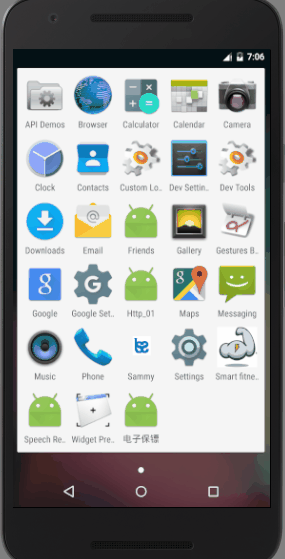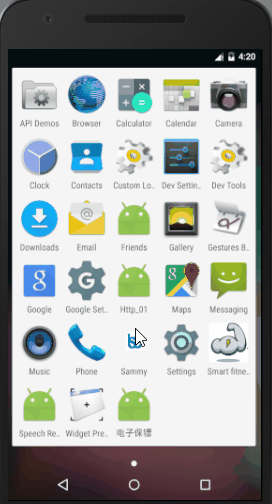本人水平有限,文章中如果出现什么不正确或者模糊的地方,还请各位小伙伴留下评论,多多指教 : )
Http概述
什么是Http
采用知识点的形式,个人认为会更加高效直观一点。
- HTTP,即超文本传输协议
- 它定义了浏览器(客户端的一种),如何向服务器请求文档,以及服务器怎样把文档传送给浏览器(客户端)
- HTTP面向应用层,它是万维网上能够可靠交换文件(声音、文本、图片等各种多媒体文件)的重要基础
Http基本工作流程
一次Http操作称为一个事务,其工作流程可以分为四步:
1)客户机与服务器建立连接
2)连接建立完成后,客户机发送请求,请求方式的格式为:统一资源标识符(URL)、协议版本号,后面是MIME信息包括请求修饰符、客户机信息和可能的内容
3)服务器接收到请求后,给予相应的响应信息。
4)客户端接收到服务器返回的状态行,并面向用户作出相应的显示,最后客户端断开连接

HttpUrlConnection
小栗子1_通过WebView加载网页
栗子描述:使用HttpUrlConnection访问百度的网址,然后把它的网页源码在WebView上面显示
首先我们新建一个项目,在AndroidManifest.xml加入网络访问的权限
<uses-permission android:name="android.permission.INTERNET" /> 布局文件 main_activity .xml
<?xml version="1.0" encoding="utf-8"?>
<LinearLayout xmlns:android="http://schemas.android.com/apk/res/android"
android:orientation="vertical" android:layout_width="match_parent"
android:layout_height="match_parent">
<WebView
android:id="@+id/webview"
android:layout_width="match_parent"
android:layout_height="match_parent"/>
</LinearLayout>接下来我们要创建一个线程类,因为网络操作一般都是比较耗时的操作,我们不能直接在ui线程中去完成这类耗时操作。
HttpThread.class
public class HttpThread extends Thread {
private String url; //访问的url
private WebView webView ;
private Handler handler ;
//构造函数
public HttpThread(String url, Handler handler, WebView webView) {
this.url = url;
this.handler = handler;
this.webView = webView;
}
@Override
public void run() {
//在这里完成网络连接的逻辑代码
try {
//第一步:拿到传递进来的url
URL httpurl =new URL(url);
//第二步:通过url的openConnection,拿到HttpURLConnection
HttpURLConnection httpURLConnection = (HttpURLConnection) httpurl.openConnection();
//第三步:通过httpURLConnection,对网络访问进行设置
httpURLConnection.setReadTimeout(5000); //设置请求超时时间
httpURLConnection.setRequestMethod("GET"); //请求方式GET
//第四步:准备接受网页回传的信息,通过StringBuffer
final StringBuffer stringBuffer =new StringBuffer();
String str;
//调用httpURLConnection的getInputStream方法获取输入流,然后再创建包装类BufferedReader
BufferedReader bufferedReader =new BufferedReader(new InputStreamReader(httpURLConnection.getInputStream()));
//不断去读取输入流中的数据,并拼接在StringBuffer当中
while((str=bufferedReader.readLine())!=null){
stringBuffer.append(str);
}
handler.post(new Runnable() {
@Override
public void run() {
//在这里拿到webView
webView.loadData(stringBuffer.toString(),"text/html;charset=utf-8",null);
}
});
} catch (MalformedURLException e) {
e.printStackTrace();
} catch (IOException e) {
e.printStackTrace();
}
}
}对应的MainActivity中的代码就非常简单了
public class MainActivity extends Activity {
private WebView webView;
private Handler handler=new Handler();
@Override
protected void onCreate(Bundle savedInstanceState) {
super.onCreate(savedInstanceState);
setContentView(R.layout.main_activity);
webView= (WebView) findViewById(R.id.webview);
new HttpThread("http://www.hao123.com",handler,webView).start();
}
}只是去加载一些布局,并开启我们之前写的HttpThread的线程即可
效果图:
最后在总结一下HttpUrlConnection的使用方法:
第一步:设置网络访问的权限,并定于URL对象(统一资源定位符)
第二步:通过URL,拿到HttpURLConnection对象,进而对网络进行设置
第三步:调用HttpURLConnection的getInputStream方法拿到输入流,在本例子中,输入流输入流内容即为网址的源代码
第四步:然后通过BufferReader去处理获取的输入流,通过不断读取缓冲BufferReader缓冲区的内容,将数据添加到StringBuffer当中
第五步:将数据加载到WebView当中
至此,这个小例子就全部完成了,是不是很简单呢~
小栗子2_下载网络图片并显示
这个例子在上面例子的基础之上加以改进
首先,我们修改布局文件,让WebView组建隐藏掉,然后加入ImageView用于显示图片
<?xml version="1.0" encoding="utf-8"?>
<LinearLayout xmlns:android="http://schemas.android.com/apk/res/android"
android:orientation="vertical" android:layout_width="match_parent"
android:layout_height="match_parent">
<WebView
android:visibility="gone"
android:id="@+id/webview"
android:layout_width="match_parent"
android:layout_height="match_parent"/>
<ImageView
android:id="@+id/image"
android:layout_width="match_parent"
android:layout_height="match_parent" />
</LinearLayout>然后在MainActivity当中实例化这个ImageView
接下来我们重新创建一个线程类,命名为HttpThread2,这个线程类和HttpThread类中做的工作差不多,通过HttpUrlConnection从网络上去下载图片,并通过ImageView显示
实例图片的URL:http://115.28.28.149/img/001.png
大家可以点击试试看,这个图片是我放在阿里云服务器上的一张。
HttpThread2类的代码
public class HttpThread2 extends Thread {
private ImageView imageView;
private Handler handler;
private String url;
//线程2传递3个参数,第一个参数是要显示的ImageView,第二个参数是一个在主线程中定义的Handler,第三个参数是要下载图片的Url
public HttpThread2(ImageView imageView, Handler handler, String url) {
this.imageView = imageView;
this.handler = handler;
this.url = url;
}
@Override
public void run() {
try {
URL httpUrl=new URL(url);
HttpURLConnection httpURLConnection = (HttpURLConnection) httpUrl.openConnection();
httpURLConnection.setRequestMethod("GET");
httpURLConnection.setReadTimeout(5000);
//可以获取到输入流
httpURLConnection.setDoInput(true);
//获取输入流,格式为图片二进制式
InputStream in=httpURLConnection.getInputStream();
//把图片下载到本地
//文件输出流
FileOutputStream fileOut ;
//下载目录
File downLoadFile=null;
//文件名称
String fileName=String.valueOf(System.currentTimeMillis());
//判断sd卡是否存在
if(Environment.getExternalStorageState().equals(Environment.MEDIA_MOUNTED));
//如果sd卡存在,则父目录即为SD卡目录
File parent =Environment.getExternalStorageDirectory();
//确定下载的目录,第一个参数传递父目录,第二个参数为目录的名称
downLoadFile =new File(parent,fileName);
//确定输出流对应的输出目录
fileOut=new FileOutputStream(downLoadFile);
//创建缓冲区,用于从数据流中不断读出数据
final byte[] b=new byte[2*1024];
//指定长度
int len;
if (fileOut!=null){
//如果文件输出流不为空,则进行数据读取
while ((len=in.read(b))!=-1){
//in.read(b),以2kb读取数据流,!=-1即说明依然有数据
//讲读取的数据流写入到fileOutStream当中,第一个参数是写入的数据源,第二个参数是起始位置,第三个参数是
//结束位置
fileOut.write(b,0,len);
}
}
//读取文件的BitMap,BitmapFactory.decodeFile(下载图片的路径),将图片的数据进行解码,变成一副位图
final Bitmap bitmap = BitmapFactory.decodeFile(downLoadFile.getAbsolutePath());
//通过handler去更新UI
handler.post(new Runnable() {
@Override
public void run() {
imageView.setImageBitmap(bitmap);
}
});
} catch (MalformedURLException e) {
e.printStackTrace();
} catch (FileNotFoundException e) {
e.printStackTrace();
} catch (ProtocolException e) {
e.printStackTrace();
} catch (IOException e) {
e.printStackTrace();
}
}
}上面有非常详细的注释,就不多做解释了,这里涉及到了一些文件目录操作和数据读写,所以没有基础的小伙伴看起来可能会有点吃力,大家可以自行百度涉及到的几个类。
接下来就是MainActivity中的代码
public class MainActivity extends Activity {
private WebView webView;
private Handler handler=new Handler();
private ImageView imageView;
//图片的下载地址
private String url="http://115.28.28.149/img/001.png";
@Override
protected void onCreate(Bundle savedInstanceState) {
super.onCreate(savedInstanceState);
setContentView(R.layout.main_activity);
imageView= (ImageView) findViewById(R.id.img);
//开启HttpThread2
new HttpThread2(imageView,handler,url).start();
}
}
最后一定不要忘记在Manifest文件中加入对sd卡的相应权限
<uses-permission android:name="android.permission.WRITE_EXTERNAL_STORAGE"/>大功告成!~!~,现在我们来看一下效果图
至此关于Http在android之中的一些基本使用就介绍完毕了,通过2个简单的例子,我们成功地从网络上取得了数据,并在android上进行显示。
在后面的博客中,我将进一步地去介绍android中关于http使用的内容~
敬请期待~(≧▽≦)/
























 1782
1782

 被折叠的 条评论
为什么被折叠?
被折叠的 条评论
为什么被折叠?








